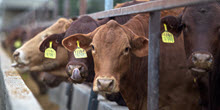Research targets groundbreaking BRD tests

Finding diagnostic tools to efficiently and objectively identify Bovine Respiratory Disease (BRD) in Australian feedlot cattle is the focus of an ambitious new research project that could potentially transform the industry.
The project, Metabolomics of Bovine Respiratory Disease, is a grainfed levy project being managed by Meat & Livestock Australia (MLA) in consultation with the Australian Lot Feeders’ Association (ALFA).
Led by Associate Professor Luciano González from The University of Sydney, Camden NSW, the project has three distinct objectives.
“There remains a huge challenge in trying to objectively identify sick animals in feedlots. The industry currently relies on visual observations of animals to detect BRD in the first instance, so it’s not an objective measure,” Associate Professor González said.
“Diagnosis for BRD in feedlots is based on visual and sound scoring of breathing difficulty, nasal and eye discharge and lethargy, with the use of rectal temperature above a defined level to trigger treatment protocols.
“What we want to do in this project is find new objective ways to identify sick animals. Further, we want to determine the true cost of the disease to the industry.”
The first goal of the project is to explore a possible BRD diagnostic tool known as metabolomics.
Metabolomics is a recent field of science that examines the metabolite profile of body tissues and fluids. The project will examine blood samples from both sick and healthy animals to discover informative biomarkers that could lead to the development of practical and cost-effective tests for BRD in feedlot cattle.
“We will do blood tests at two stages – at induction and then again at any time the animal is deemed to be sick by the pen riders and pulled out for inspection and treatment,” Associate Professor González said.
“For every sick animal removed from the pens, we’ll also pull out a healthy animal, so we can compare the blood results and body temperatures.”
The second goal of the project is to determine for the first time, the economic impact of BRD to Australian feedlots, by a retrospective analysis of BRD treatment records and lung abnormalities at slaughter accounting for treatment cost, loss of production, labour cost and opportunity cost, amongst others.
“We want to quantify every factor that may have a cost,” Associate Professor González said.
“The research is being undertaken at a commercial feedlot, with approximately 1760 animals set to be followed for 60 days from induction.
“The cattle will then be followed right through to the abattoir to measure lung scores for signs of adhesions and abscesses to see if there’s any evidence an animal has had an incidence of BRD.
“A lot of feedlot cattle could go undetected for BRD and it’s not until they arrive at the abattoir that we realise an animal has been sick because we can see lesions on their lungs.
“We will also be looking at carcase data to measure the impact of BRD on meat quality and yield.”
Associate Professor González said the project’s third objective is to research a method of automatic detection of fever, using a technology known as infrared thermography.
“This technology is capable of measuring the temperature of objects from long distances,” he said.
“We have different versions of the technology we’ll be using – from a little sensor that attaches to a mobile phone, through to a camera that can be set up in a race or pen.
“It allows us to measure body temperature without touching an animal, potentially improving animal management, reducing the use of antibiotics, and making treatments more effective.”
MLA Feedlot Project Manager, Dr Joe McMeniman, said with the adoption of antimicrobial stewardship guidelines by the feedlot industry, there will be an increasing requirement for accurate and objective case identification of BRD.
“We know that BRD is the leading cause of morbidity and mortality in Australian feedlot cattle. However, the true cost of diseases in feedlot cattle is largely unknown as there are hidden costs in managing sick animals such as feed consumption, time required for treatment and disposal where necessary,” Dr McMeniman said.
“Following animals in the study through to the abattoir will provide valuable insights.
“BRD results in lung damage of feedlot cattle with the signs commonly evident at slaughter.
“Research conducted in the United States reports that cattle with lung abnormalities have decreased carcase weight and fatness, including marbling. Additionally, up to 50% of cattle with lung abnormalities at slaughter exhibit no clinical signs of BRD during the feeding period. These undetected animals are termed ‘sub-clinical’.
“No peer-reviewed data is available on the sub-clinical incidence of BRD of Australian feedlot cattle.
“This project will generate data to quantify the economic impact of Bovine Respiratory Disease (BRD) to Australian feedlots via an analysis of feedlot induction records, BRD treatment records and lung abnormalities at slaughter.”



